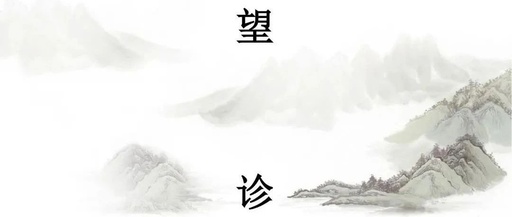ObservationalDiagnosisNotes
Observation Diagnosis
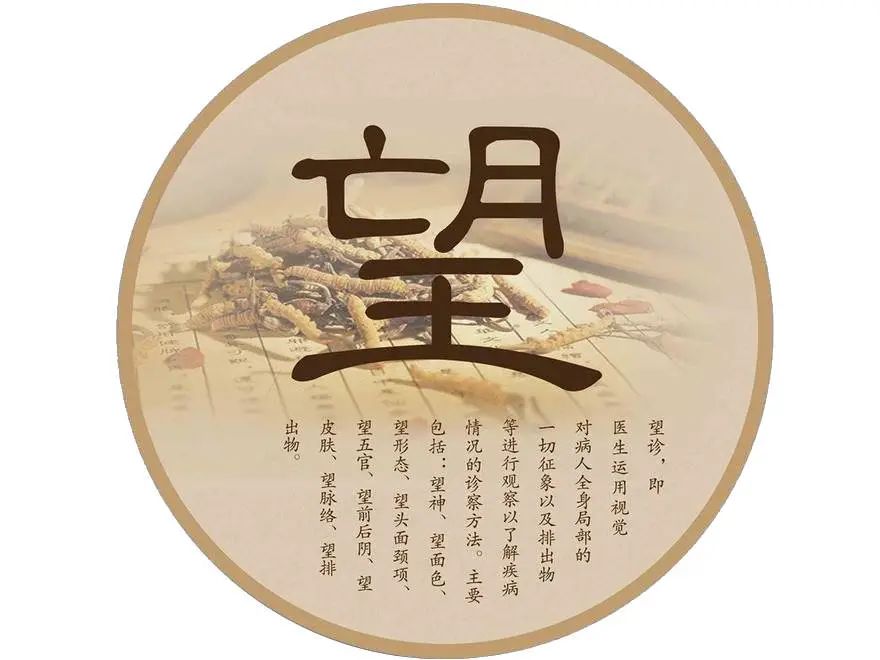
Concept of Observation Diagnosis
The method by which doctors use visual observation of the patient’s overall and local manifestations, tongue appearance, and excretions to collect information about the condition.
Principle of Observation Diagnosis
The human body is an organic whole, where the heart governs, and the organs are central. Each part of the body is connected through the meridians, thus forming an inseparable relationship between the internal organs and the body.
Therefore, by observing various external manifestations of the body, one can assess the strength and weakness of organ functions and the balance of Qi (vital energy), blood, Yin, and Yang, thereby determining the condition of the disease.
Observation of Spirit
1. Concept and Principle of Observation of Spirit
1. Concept of Spirit
Spirit refers to the totality of life activities in the human body.
It includes two meanings:
Broadly – refers to the external manifestations of life activities: life.
Narrowly – refers to the mental activities of the body: spirit.
2. Principle and Significance of Observation of Spirit
① Essence generates spirit, and spirit governs essence; when essence is sufficient, the body is strong, and when the body is strong, the spirit is vigorous.
② Observation of spirit can reveal the abundance or deficiency of the essence and Qi of the organs: “Those with spirit thrive, those without spirit perish.”
3. Key Points of Observation of Spirit: gaze (focus), expression, complexion, posture, speech and behavior, responses.
2. Observation of Spirit: manifestations and clinical significance of having spirit, lacking spirit, false spirit, and chaotic spirit.
1. Having Spirit: presence of spirit, sufficient essence, abundant Qi, and vigorous spirit.
Clinical significance: the righteous Qi is not harmed, organ functions are not weakened, and the prognosis is good.
2. Lacking Spirit: insufficient spirit and Qi.
Clinical significance: manifestations of insufficient essence and weak spirit.
3. Losing Spirit: absence of spirit, depleted essence, and weakened Qi.
Clinical significance: the righteous Qi has been harmed, and organ functions are failing (deficiency).
4. False Spirit: a temporary improvement in spirit in critically ill patients, a premonition before death (“return of light”, “flickering of a dying lamp”).
Clinical significance: depletion of organ essence and Qi, Yin and Yang are about to separate, with Yang escaping outward.
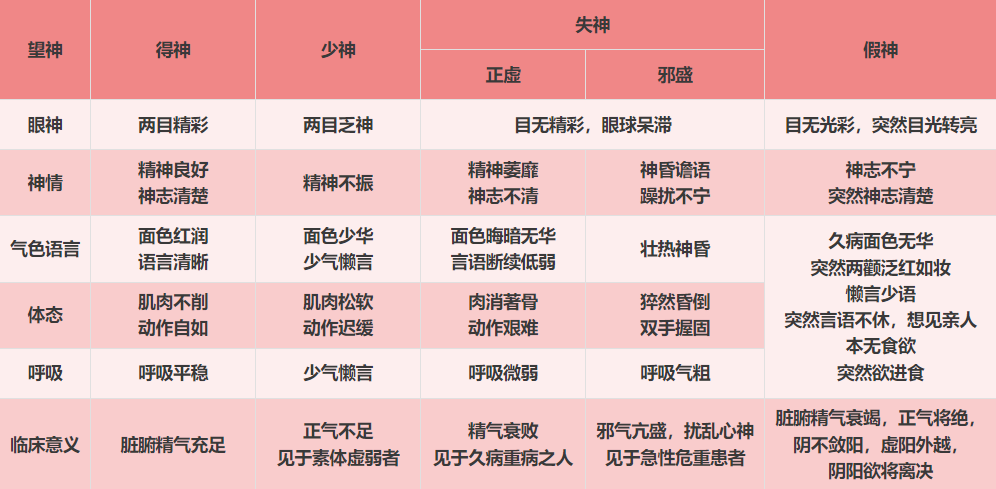
5. Chaotic Spirit: refers to mental confusion or abnormal consciousness, clinically manifested as anxiety, fear, agitation, apathy, or sudden fainting, commonly seen in patients with epilepsy, mania, seizures, and organ disorders.

3. Considerations for Observation of Spirit
1. Pay attention to the first impression during patient examination.
2. Ensure the spirit and form are correlated.
3. Focus on significant symptoms and signs.
4. Distinguish between false spirit and genuine improvement in severe illness.
Observation of Color
1. Concept and Principle of Observation of Color
Observation of color, also known as color diagnosis, is a method by which doctors diagnose conditions by observing changes in the color of the patient’s skin, primarily focusing on the face.
2. Concepts of Normal Color and Disease Color
1. Normal Color: the color of the skin on a healthy person’s face.
[Characteristics] Bright, moist, and subtle.
2. Disease Color: the color displayed on the face during a disease state.
[Characteristics] Dull, exposed.
Normal color is divided into main and guest, while disease color has good and bad.
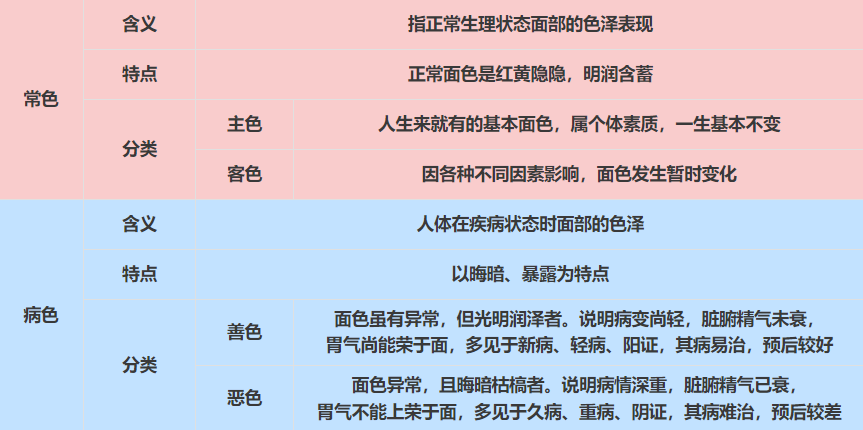
3. Differentiation between Normal Color and Disease Color (Good Color, Bad Color)
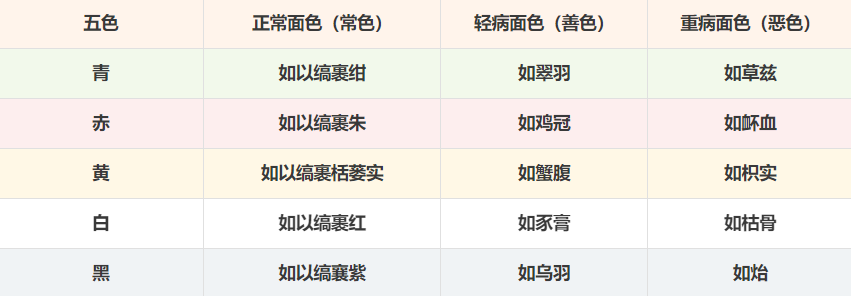
3. Correspondence of Facial Regions to Organs
Ancient physicians summarized from long-term clinical practice based on the principle of “external signs reflecting internal conditions” (as seen in “Lingshu: Five Colors” and “Suwen: Discussion on Needling Heat”) that facial complexion corresponds to the organs.
1. Facial Names and Corresponding Organs from “Lingshu: Five Colors”
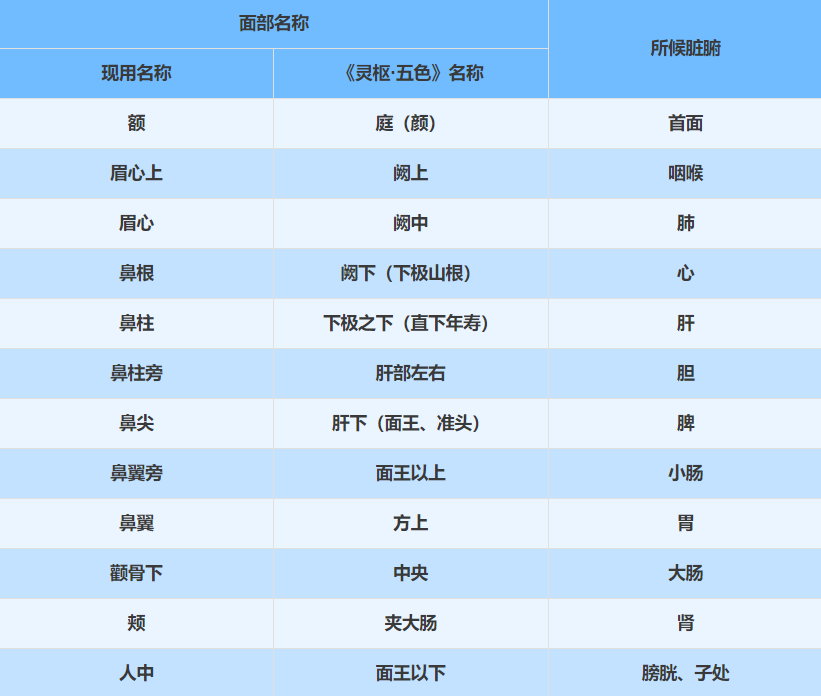
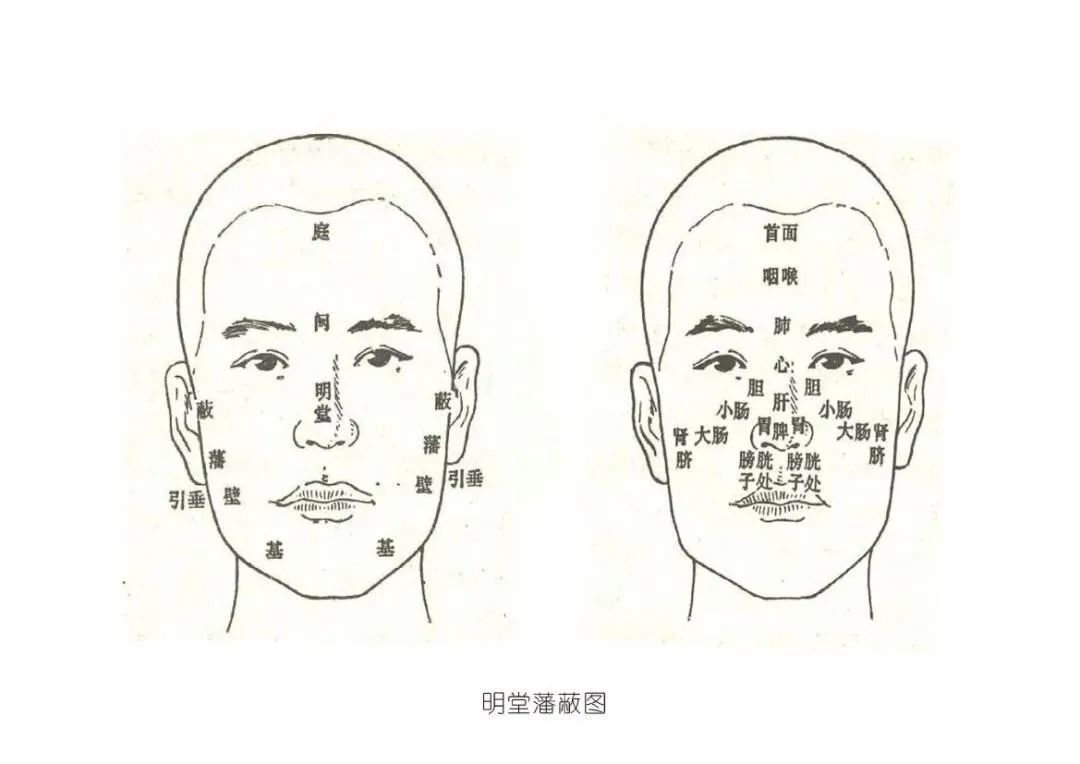
2. Facial Names and Corresponding Organs from “Suwen: Discussion on Needling Heat”

4. Main Diseases Corresponding to the Five Colors

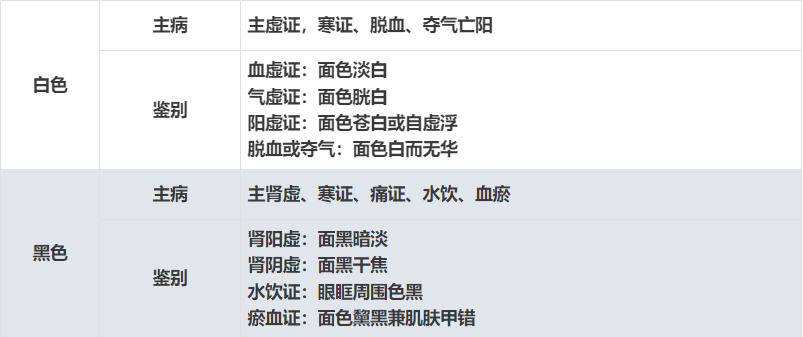
Table of Main Diseases Corresponding to the Five Colors
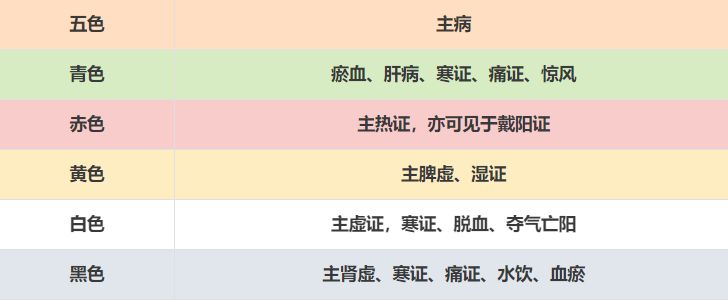
5. Ten Methods of Observation of Color
Floating and sinking → exterior and interior;
Clear and turbid → Yin and Yang;
Subtle and severe → deficiency and excess;
Scattered and concentrated → new and old;
Moist and dry → light and heavy.
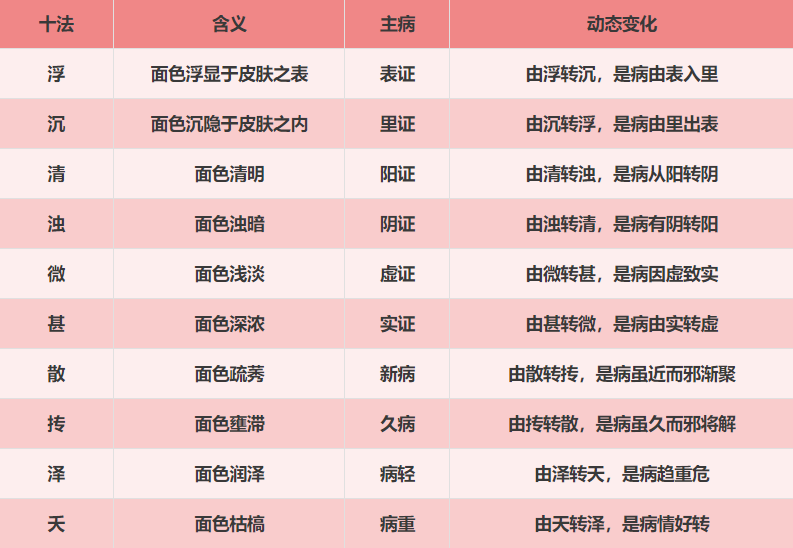
Observation of Body Shape
1. Concept of Observation of Body Shape
Observation of body shape involves examining the strength, weight, and abnormal manifestations of the patient’s body to diagnose conditions.
2. Observation of Body Shape: Manifestations and Clinical Significance of Strong, Weak, Fat, and Thin
1. Body Strength:
① Strong body: broad chest, large bones, moist skin, and full muscles; indicates solid internal organs, abundant Qi and blood, and strong resistance to disease.
② Weak body: narrow chest, small bones, dry skin, and thin muscles; indicates weak internal organs, insufficient Qi and blood, and weak resistance to disease.
2. Body Fat and Thin:
① Obesity: weight exceeding normal standards by 20%.
→ Excess body shape: fat but able to eat.
→ Excess body shape with Qi deficiency: fat but eats little.
② Thinness: significant weight loss, more than 10% below standard weight.
Thin body with increased appetite → fire in the middle burner;
Thin body with decreased appetite, pale tongue, and loose stools → weak middle Qi;
Prolonged illness with bedridden state, emaciated body → depletion of organ essence and Qi, dryness of Qi and fluids.

Observation of Posture
1. Concept of Observation of Posture
Observation of posture involves examining the patient’s movements, static and dynamic postures, and abnormal actions to diagnose conditions.
2. Content of Observation of Posture
1. Dynamic and Static Postures:
① Active, strong, upright, and extended → Yang syndrome, heat syndrome, excess syndrome;
② Static, weak, bent, and flexed → Yin syndrome, cold syndrome, deficiency syndrome;
2. Weak and exhausted posture: indicates deficiency of organ essence and Qi, severe illness.
3. Abnormal actions:
① Eyelids, face, lips, fingers (toes) tremble intermittently;
② Finger twitching → internal movement of wind (Yin deficiency);
③ Abnormal movements of limbs.
3. Common manifestations of abnormal postures and their clinical significance.
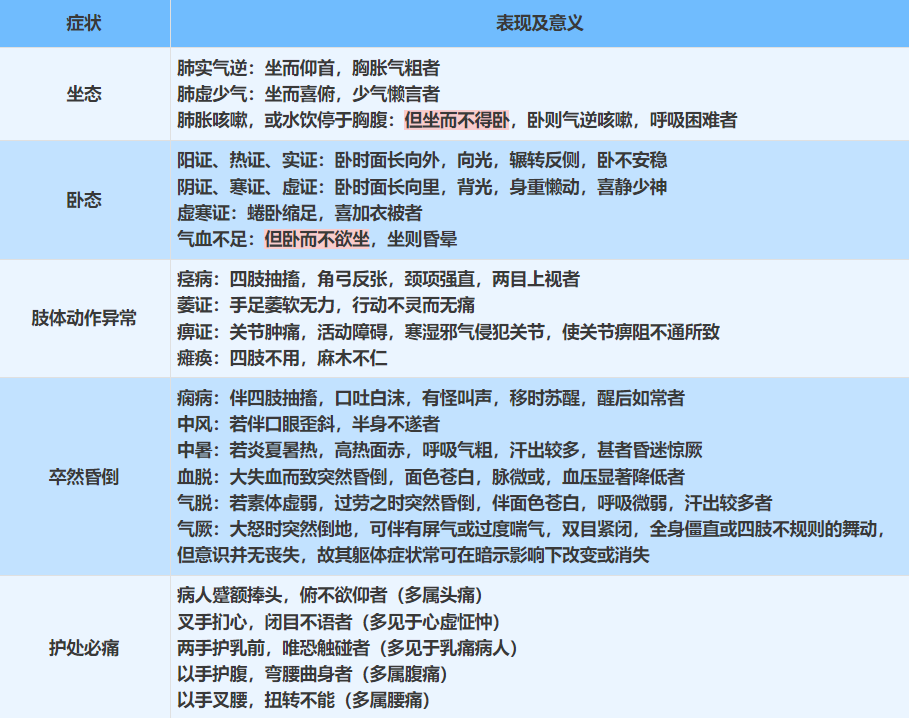
 END
END
 Share
Share Collect
Collect In View
In View Like
Like

